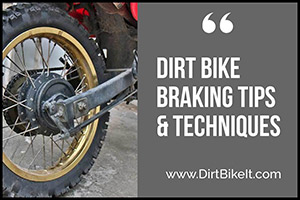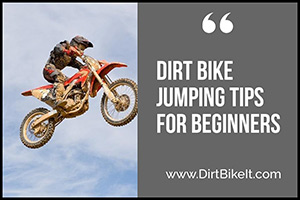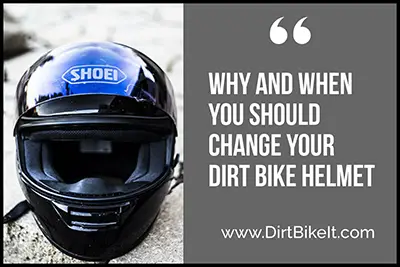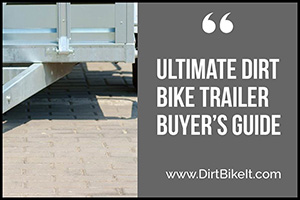Dirt Bike Braking Tips & Techniques. How to Stop Faster
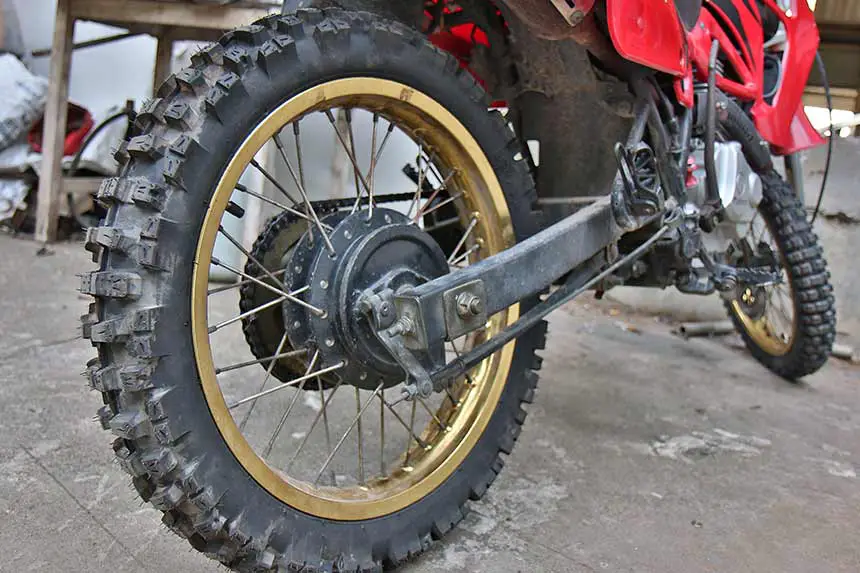
Dirt Bike Braking Tips & Techniques. How to Stop Faster
Having a good solid braking technique helps a lot in improving your dirt bike riding abilities. Some people brake too much, others too little; some brake too late, others too early; some brake at the wrong time, others in the wrong place; and some people don’t know how to balance the use of the front and rear brakes.
Braking: What You Should Understand Before Making A Mistake
If you’re a beginner at dirt bike riding, know that falling is a part of the process of learning. It may even happen quite often, possibly each time you ride. But don’t let that discourage you; remember that mastering how to ride a dirt bike is something that takes time, dedication and patience. However, having said that, you don’t want to fall unnecessarily. You can avoid this by being aware of a few basic errors that beginners tend to make with their braking. Just be mindful of these, and your control over your vehicle will increase exponentially.
Don’t Brake Too Early
One of the mistakes that beginning dirt bike riders make is to brake too early, especially when going around a corner. This is particularly disadvantageous if you’re racing, taking up valuable time, as it does. What you want to do is to attack the corners, going deep into them before braking, not braking before that. Slowing down when approaching a corner can cost you more time than you would at first think.
Front Brake Why You Should Depend on It
70% of your dirt bike’s stopping power comes from the front brake. When you use your brakes, use them firmly, pressing down on them hard; don’t press on them uncertainly; be strong, certain and decisive. You generally want to apply both breaks together, but if you have to make a sudden stop, you can rely on the front brake to do it for you.
Roughly 75% of your braking should be applied using the front brake. Sometimes people avoid the front brake out of fear that their front wheel will lock up. But the best brake occurs right before the front wheel starts skidding. So, the fear is one that you’ll have to face.
Practice is really important if you want to perfect your braking technique. In order to practice, you will need to find a surface that is consistent and smooth. During practice, be sure to apply the brake hard, just enough to start the front wheel locking up. As your practice improves your riding skills, try to actually lock up your front wheel, maintaining your balance all the while. This will come in handy when you hit patches of loose terrain where the front wheel does lock up by accident.
As you get better, practice the front brake on mixed terrain, getting a sense of how to apply the front brake differently on different surfaces. Always keep at least one finger on the front brake, or two if you’re just a beginner, to help apply the maximum brake every time.
Rear brake
The rear brake of your dirt bike is used mostly for directional control. Run your rear brake pedal low, as low as you can. Keep your foot on the rear brake pedal, so that you don’t have to move it much at all when you want to press on the rear brake. This allows you to brake quickly if needed, permitting you to react faster. Setting up this way is not ideal for riding on downhill sections, but it works in tight trails. Running your rear brake pedal really low allows you to have greater reaction time and better control over your dirt bike compared to setting up higher.
Practice is really important, especially for beginning riders. One great way to drill your rear braking skills is by employing the rear brake to plop your bike back down after a wheelie. Find an empty space, slightly uphill, where you can practice. Perform wheelies there through an interplay between your throttle and rear brake. In the beginning perform small wheelies while in the first gear. Once you get the hang of doing this in the first gear, try the second. Focus on performing controlled and smooth wheelies. This will undoubtedly improve your riding skills.
Engine Brake: How to Use It
Engine braking refers to the slowing down of your vehicle by using the retarding forces inside in an engine rather than the external braking mechanisms available, such as the front and rear brakes on your dirt bikes. Engine braking would allow you to apply the brakes without using the front or rear brakes. Sometimes, it’s as simple as rolling your hand off the throttle. More often however, it refers to moving from a higher to a lower gear, creating a slowing down effect on the bike. Engine braking isn’t a question of right or wrong. It simply comes down to personal preference.
Braking Point
Your braking point (not to be confused with breaking point) is, as the name implies, the point at which you apply the brakes, particularly when you are going around corners. Most riders tend to brake too early when it comes to corners, wasting valuable time if they’re racing. Therefore, braking points are particularly important to riders concerned with speed or riders who are looking to participate in a race. What you want to do is to pick a rather small endure loop, marking out the places where you are applying your brakes. Have a friend measure the time it takes you to get around the entire loop. Once you have a sense of how long you are taking for each loop, start moving your braking point markers forward, so that you brake at a later time. Stop moving the braking point markers forward once you start overshooting corners, getting the minimum possible braking distance on every corner. Measure your time again. You will be pleased at the improvement.
Braking Hard: Safety First
While you want to apply the brakes firmly, you don’t want to jam down on them hard all at once. This can create safety hazards. Applying your front brake hard will not cause your bike to skid uncontrollably. It will, however, skid uncontrollably and probably throw you off if you jam your front brake really hard. Make sure you apply your front brake in a progressive manner, progressing from a gentle squeeze to a hard one in stages. This way, the bike may still skid, but it will skid in a controllable way.
The rear wheel, on the other hand, will skid easily upon application of the rear brake, with most of the weight being on the front wheel. If the rear wheel skids when you apply the rear brake, simply make sure that you keep your eyes on where you want to go. Don’t panic under any circumstances.
Brake Sliding: What is That?
Brake sliding is a technique usually applied in dirt bike racing, where the rider releases the front break while applying the rear break, causing the rear wheel to lock up, the bike skidding or sliding for a certain distance before which acceleration is applied again. Brake sliding is used to shorten corners or increase the distance of the straight. It is often used to overtake other riders in a race. This technique is not for the casual rider, as it requires a lot of practice and experience.
Standing Through Braking When is That Allowed?
You should, generally speaking, be in a standing position when you apply the brakes. The position you should be standing in is called the central standing position. It involves positioning your feet on the foot pegs, from where they can easily access the foot levers. The bike should be gripped using your knees, keeping them slightly bent, positioned close to the tank’s bottom. Keep your back arched slightly, arms up, elbows forward, head above the handlebars. Keep a finger or two over the brake and clutch levers. This will possibly feel weird in the beginning, but with practice it will start to feel natural.
Use both breaks together in a smooth manner. Don’t use jerky motions to apply the brakes. This can cause the wheels to lock up, throwing you off, particularly if you’re going at high speeds. Use engine brakes to help you slow down.
Seating Position When Braking Good or Bad?
As a general rule, you should try and maintain a central standing position while you’re out riding your dirt bike. But it does sometimes depend on the terrain you’re riding. If you’re on tight, twisting trails, you may find yourself sitting more often than if you’re riding on a wide, expansive terrain. However, while braking, you probably want to remain in a central standing position. Otherwise the damage that the impact of braking would cause to your privates could be quite painful. Better to let your knees and legs absorb the shocks of braking.
Extreme Descents: What to Watch For ?
When you’re riding on extreme descents, you want to make sure that you maintain the proper body position (standing) and always look ahead. You may occasionally move your hips to the fender of the bike when the descent gets very steep. This will elongate your elbows; keep them straight but don’t lock them out. Keep your body fairly loose; steep descents tend to tense riders up.
Use both brakes while on steep descents, with greater emphasis placed on the front brake. Use the rear brake to stabilize your bike as it goes downhill. Keep one finger on the clutch, ready to pull it in should the back wheel threaten to lock up. If you’re heading down at a little bit of speed, consider using engine brakes to slow the bike down and prevent the rear wheel from locking up. Don’t apply the brakes when the descent becomes very steep, but let the bike build up speed. Apply the brakes again when the terrain flattens out a little.
If the terrain gets so steep that it feels unsafe to ride on, paddle your way down with your feet. If it feels too steep even for that, switch off your engine and walk your bike down. Remember to always put safety first.
Braking While Cornering You Better Learn That
Braking while cornering is tricky and requires lots of practice, particularly if you’re going to be racing, looking to turn your corners as fast as possible. Make sure that you are in the right gear and have applied your brakes before getting into the turn. This is particularly important for clockwise (righthand) turns, where you need to remove your foot from the brake to extend it for the turn. Make sure that you apply the brakes gently, without stomping on them too hard or suddenly.
